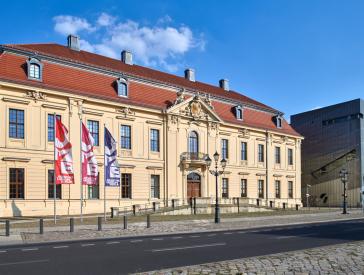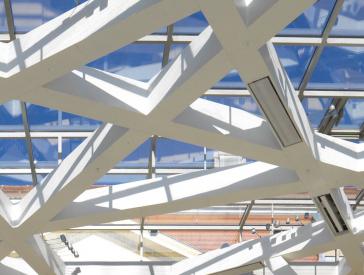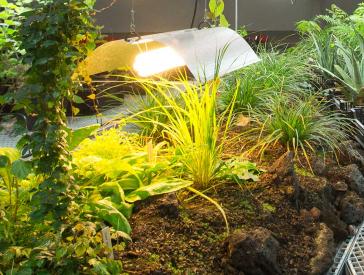
The Glass Courtyard
A Sukkah Made of Glass and Steel
A glass and steel construction completed in September 2007 encloses the 670-square-meter courtyard of the baroque eighteenth-century Old Building. The Glass Courtyard is an atrium built according to the “Sukkah” (Hebrew “booth”) design plans of architect Daniel Libeskind. The design refers to Sukkot, the Jewish Feast of Booths or Tabernacles, a harvest festival remembering the huts the Israelites lived in as they wandered the desert after escaping slavery in Egypt.

Where
Old Building, ground level, Glass Courtyard
Lindenstraße 9–14, 10969 Berlin
A Complex Building Project
The glass roof is supported by four freestanding bundles of steel pillars. Their form calls to mind the branches of a tree, extending under the roof in a steel network. The glass façade looks out onto the spacious Museum Garden.
The Glass Courtyard was a complex building project, unconventional in both its form and materials. The intricate steel branches and treetops represent one of the most unusual uses of steel in contemporary architecture. The glass façade consists of nine different types of pane, mirroring the Libeskind building and the trees in the Museum Garden. The result is a transparent space full of reflections and flooded with light.
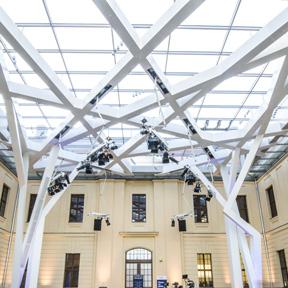
Six years after the opening of the Jewish Museum, Daniel Libeskind created the glass courtyard. Learn more about its architecture in the JMB app.
Read along: Glass courtyard – A sukkah as an idea
Daniel Libeskind: “I was very glad to be able to build this structure, I called it kind of a sukkah. It’s based on, it’s got four trees. It’s glass, it’s very, very different. It’s a very different time, it’s a very different function. And it’s something looking forward, something fun to be in, where you still see the baroque building, but you see the life of the Jewish museum moving forward.”
Six years after the Jewish Museum opened, Daniel Libeskind created an additional special space – this _Glass Courtyard_. He covered over the courtyard of the old baroque building with a generous glass facade overlooking the garden. The four white steel girders – each weighing six tons – look like trees, the ‘branches’ of which resemble the oversized crown of a tree spreading below the glass roof.
These natural references are consciously chosen. A sukkah, or hut, is a structure with a partly open roof of leaves or some other natural material, which is built for Sukkot, the Feast of Tabernacles or the Festival of Ingathering.
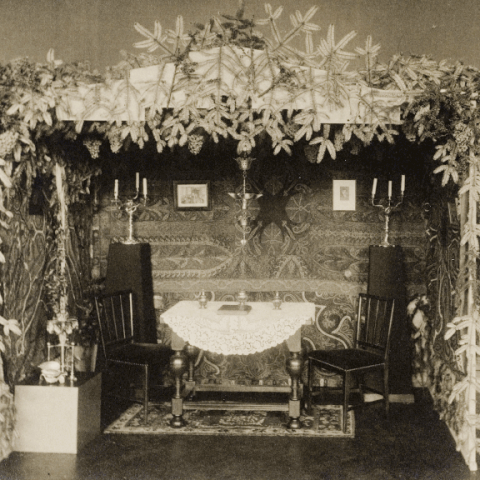
The glass courtyard was inspired by sukkot. Learn about how varied these temporary huts can be in the JMB app's "Can you find the Sukkah?" game; photo: Collection Jewish Historical Museum Amsterdam
Read along: Glass courtyard – A social place
Daniel Libeskind was thinking about a sukkah when he designed the Glass Courtyard.
A sukkah is an improvised hut, built for Sukkot, the Feast of Tabernacles or the Festival of Ingathering. Every autumn, Jews commemorate the 40 years the Israelites spent wandering the desert, during which they lived in huts. In remembrance of this time spent in Egypt before reaching the Promised Land, some Jews eat in a sukkah. Some also sleep there, weather permitting. A sukkah has to have at least three stable walls …
… just like this Glass Courtyard.
Its roof must be covered in such a way that the sky and stars can be seen through it …
… as is the case here.
The sukkah is also a sociable place for eating together.
Just as you can spend time in the Glass Courtyard – meet friends and eat and drink together. The Jewish Museum also uses the space for concerts, conferences and discussions. This social dimension is important to Daniel Libeskind. He associates the structure not just with the Feast of Tabernacles but also with Jewish wedding ceremonies, which are conducted under a canopy known as a chuppah.
Daniel Libeskind: “A sukkah is a kind of chuppah. It’s a cover, a celebratory structure that even has the dynamics woven into it. And I thought, not to construct just a roof and glass barks and just seal the building, but something that was permeable, something that had also reference to nature in its own way, something that reminded us of other traditions that are part of the Jewish Museum.”
Venue for Diverse Events
The Glass Courtyard thus provides an architecturally appealing and atmospheric environment for the museum’s diverse cultural and educational programs. The Glass Courtyard has a capacity of 500 and is well suited for educational workshops, concerts, conferences, and receptions. The Glass Courtyard can also be rented. Information on renting the space is available on our website.
With the support of the Friends of the Jewish Museum Berlin
Our Buildings: Daniel Libeskind and the Baroque Era (6)



